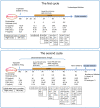Case report: Birth achieved after effective ovarian stimulation combined with dexamethasone in a patient with resistant ovary syndrome
- PMID: 35392972
- PMCID: PMC8988423
- DOI: 10.1186/s13048-022-00976-4
Case report: Birth achieved after effective ovarian stimulation combined with dexamethasone in a patient with resistant ovary syndrome
Abstract
Background: Resistant ovary syndrome (ROS) is a rare endocrine disorder and there have been few reports of live births by affected patients. As gonadotropin resistance leads immature oocytes, some researchers reported few live births with in vitro maturation (IVM) of oocytes, but IVM is not always successful in ROS patients. Here, we report an original case of ROS, associated with Ig-FSHR in the serum, who achieved a live birth following ovarian stimulation combined with dexamethasone treatment.
Case presentation: The 30-year-old woman presented with secondary amenorrhea and infertility. Her serum FSH levels were found to be higher than normal, but in discordance with a normal anti-Müllerian hormone (AMH) level and antral follicle count. Genetic investigation found no mutations potentially affecting FSHR. With reference of previous ROS studies, the patient's serum was analyzed for antibodies directed against FSHR and dot blot analysis showed strong reactivity with FSHR. Then, dexamethasone was proposed to the patient, and she successfully became pregnant, finally delivering a healthy girl by caesarean section.
Conclusion: To our best knowledge, this is the first report of the successful treatment of ROS using ovarian stimulation combined with dexamethasone. In some cases of ROS, high doses of exogenous gonadotropins in combination with immunosuppressive therapy could be an effective approach.
Keywords: Case report; Dexamethasone; Immunosuppressant; Infertility; Resistant ovary syndrome.
© 2022. The Author(s).
Conflict of interest statement
The authors declare that they have no competing of interest.
Figures



Similar articles
-
Infertility management in resistant ovary syndrome: a review.Front Endocrinol (Lausanne). 2025 Mar 18;16:1560981. doi: 10.3389/fendo.2025.1560981. eCollection 2025. Front Endocrinol (Lausanne). 2025. PMID: 40171200 Free PMC article. Review.
-
Successful in vitro maturation of oocytes in a woman with gonadotropin-resistant ovary syndrome associated with a novel combination of FSH receptor gene variants: a case report.J Assist Reprod Genet. 2019 Mar;36(3):425-432. doi: 10.1007/s10815-018-1394-z. Epub 2019 Jan 5. J Assist Reprod Genet. 2019. PMID: 30610662 Free PMC article.
-
Successful live birth in a woman with resistant ovary syndrome following in vitro maturation of oocytes.J Ovarian Res. 2016 Sep 6;9(1):54. doi: 10.1186/s13048-016-0263-6. J Ovarian Res. 2016. PMID: 27599836 Free PMC article.
-
First birth achieved after in vitro maturation of oocytes from a woman endowed with multiple antral follicles unresponsive to follicle-stimulating hormone.J Clin Endocrinol Metab. 2013 Nov;98(11):4493-8. doi: 10.1210/jc.2013-1967. Epub 2013 Aug 16. J Clin Endocrinol Metab. 2013. PMID: 23956344
-
Successful live birth after in vitro maturation treatment in a patient with autoimmune premature ovarian failure: a case report and review of the literature.Gynecol Endocrinol. 2021 Dec;37(12):1138-1142. doi: 10.1080/09513590.2021.1928065. Epub 2021 May 19. Gynecol Endocrinol. 2021. PMID: 34008458 Review.
Cited by
-
Infertility management in resistant ovary syndrome: a review.Front Endocrinol (Lausanne). 2025 Mar 18;16:1560981. doi: 10.3389/fendo.2025.1560981. eCollection 2025. Front Endocrinol (Lausanne). 2025. PMID: 40171200 Free PMC article. Review.
-
Resistant ovary syndrome: Pathogenesis and management strategies.Front Med (Lausanne). 2022 Oct 19;9:1030004. doi: 10.3389/fmed.2022.1030004. eCollection 2022. Front Med (Lausanne). 2022. PMID: 36341241 Free PMC article. Review.
-
Resistant ovary syndrome: Two case reports and a literature review of effective controlled ovarian stimulation in IVF.Medicine (Baltimore). 2024 May 3;103(18):e37886. doi: 10.1097/MD.0000000000037886. Medicine (Baltimore). 2024. PMID: 38701292 Free PMC article. Review.
References
Publication types
MeSH terms
Substances
LinkOut - more resources
Full Text Sources
Medical
Research Materials

